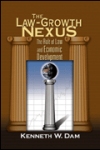In Review:
New Publications on International and Comparative Law
 |
The Law-Growth
Nexus: The Rule of Law and Economic Development
By Kenneth W. Dam, Brookings Institution Press, 2006
If scholars at the Brookings Institution missed the boat in writing about reforms in global governance by completely ignoring the judiciary and the concept of the rule of law (see IJM Volume 2, Issue 2, In Review), Brookings Senior Fellow and University of Chicago Law School professor Kenneth W. Dam makes up for this omission in his powerful study of the relationships between economic development and legal and judicial institutions. He notably devotes one entire chapter of his book to the judiciary. He sums up his basic premise in two short words: “law matters.”
Professor Dam expands on this premise in an introduction titled “Why This Book?” where he answers the question with two aims: (1) “to analyze the reasons why legal institutions are important to economic development and what aspects of the law are of particular importance” (2) “to lay out the policy implications and especially the policy means for following through on the new accent on legal institutions as a major factor in economic development.” He sums up his aims by declaring that “the rule of law is essential to economic development.”
For those who prefer a historical approach to understanding and enlightenment, Professor Dam’s book will provide gratification. His first two chapters deal with respectively “Where Does the Rule of Law Fit in Economic Development?” and “Legal Institutions, Legal Origins, and Governance.” In the first of these two chapters he analyzes the meaning of “the rule of law” from historical and contemporary perspectives. The latter chapter examines in considerable detail the origins of both the common law and the civil law systems, generally regarded as the two basic legal systems followed by most countries in the world today. The common law analysis is devoted to the legal system of England, and the civil law commentary focuses primarily on the French system. One interesting discussion in this chapter focuses on the “legal origins” approach to studying economic development. The author makes reference to a ground-breaking study published in 1998 titled “Law and Finance,” by four economists, La Porta, Lopez-de-Silanes, Schleifer and Vishny (LLSV). This study determined that “countries whose law derived from the common law had stronger legal systems for financial development and hence faster economic growth than civil law countries.” However Professor Dam’s analysis in later chapters shows that this observation is not always true.
After a short chapter on competing explanations, where he briefly discusses the roles of geography, culture (including trust, social capital, religion and social norms)values and cultural regions, and legal culture, Professor Dam returns to history in discussing the roles of “Institutions and History” in economic development.
Of special interest to readers of the International Judicial Monitor, Professor Dam devotes the entirety of Chapter 5 to the “Judiciary.” The first paragraph of that chapter contains the message that should resonate among all foreign aid institutions: “no degree of improvement in substantive law – even world ‘best practice’ substantive law – will bring about the rule of law to a country that does not have effective enforcement. A sound judiciary is the key to enforcement.” One conclusion that has been reached not only by economists but also by lawyers and legal scholars is that the judiciary is a vital factor in the rule of law and more broadly in economic development. These observations are grounded on the very simple proposition that business firms and investors are more likely to invest, or increase their investment, in those countries where they can have some confidence in the court system and the ability of judges to enforce contracts and protect property rights.
In the chapter on the judiciary, Professor Dam analyzes issues of “formalism,” the degree to which procedures affect the time and process of decision making. Other factors he discusses in this chapter successively include: judicial efficiency, judicial independence, court decisions as law, structural and behavioral independence, administrative review, and legal origins and its relation to judicial independence.
Other chapters in the book, probably of less interest to judges and lawyers and of more interest to economists and scholars, are “Contracts and Property,” “Land,” “Equity Markets and the Corporation,” and “Credit Markets, Banks and Bankruptcy.”
The final section of the book is a “Review of Some Key Themes.” In this section Professor Dam emphasizes the importance of institutions to economic development, especially legal institutions, including the legal system, the court system and the judiciary. In the 11th and last chapter, China is referenced as a ‘test case.’
Professor Kenneth Dam has provided extraordinary and valuable insights into the relationships between the rule of law, the role of lawyers, and the importance of the judiciary in economic development in the Law-Growth Nexus. His work should provide strong guidance to all governmental and non-governmental organizations that focus on economic development, especially among the poorer countries of the world, for devising strategies and plans for relief and recovery.
By James G. Apple, Co-editor of the International
Judicial Monitor and President, International Judicial
Academy
